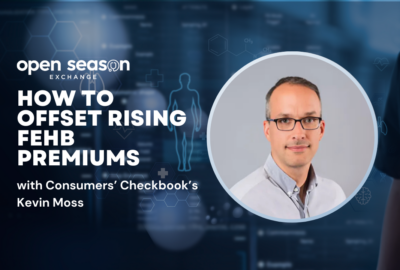Crazy About Your Doctor? Shop or Drop
With one week left to shop for health insurance you still have time to save yourself a lot of money next year or do nothing and maybe live to regret it. Senior ...
If you love (in a professional way) and can’t live without your doctor, check with him or her before you pick your 2011 health plan. Be sure that your doctor is in the network of the health plan you are in or considering. If it turns out he/she is in one or more plans, you may want to pick the one with the lowest premium.
Ensuring that your doctor(s) are within a health plan’s PPO (preferred provider option) network is very important, according to Walton Francis who literally wrote Checkbook’s Guide to Health Plans for Federal Employees. Going out of network can be very expensive, compared to the relatively small co-payments if your doctor is a preferred provider. In the Washington area, where feds and retirees have up to 27 plans to choose from, many physicians are affiliated with several plans.
The health insurance hunting seasons ends next Monday at close of business. To help workers pick the best plan for them, many federal agencies have subscribed to the on-line version of Checkbook. To see if that includes you, click here.
Meantime, here’s a quick checklist you might want to follow in selecting your 2011 health plan:
- Consider the plan’s catastrophic limit (the amount you will have to pay out-of-pocket before the plan takes over.) All of the plans, Francis says, are good and protect against catastrophic medical costs, but there are huge differences in the limits ranging from $4,000 (HMOs like Kaiser and MD-IPA) to $17,000 (Mailhandlers standard). You can double those limits for a family plan.
- Remember the 5-year rule. That is, you must be enrolled in an FEHBP plan (any one will do) for the five years prior to retirement to continue coverage into retirement. To insure that you will be eligible for lifetime FEHBP coverage after retirement, pick a low premium plan. A number of them (Kaiser,Coventry Standard, APWUCD and GEHA standard) charge only about $1,000 a year for self-only coverage. Think of it as buying insurance so you can have insurance when you retire.
- Not all health plans are the same. For a self-only policy feds and retirees in the Washington area can pay anywhere from $860 to $3,240 next year.
- If one of you is a still working fed and the other is a retired U.S. Government worker, let the working spouse buy the family policy. Thanks to what is called premium conversion working feds (but not retirees) pay their premiums with pre-tax dollars. That lowers their taxable income, and their tax bill.
- Consider setting up a Flexible Spending Account (of up to $5,000) to pay for medicines and services not covered by your health plan. Because it is pre-tax, Francis says, you “get a one-third discount on predictable out-of-pocket costs.”
- Premiums will remain flat in a few plans next year. The popular Blue Cross standard plan will go up 7 percent. Some other plans have double-digit increases. Francis says that for many workers and retirees Blue Cross basic is just as good as the standard option, but at a much lower premium.
- Consider Bargains: Checkbook says there are some real bargains in the Aetna CD & HD, APWU CD, Blue Cross Basic, Kaiser Standard, GEHA standard and HD, and Mail Handlers HD. CD stands for consumer-driven and HD stands for high-deductible. Manages properly, the guide says, and a family can save $1,000 to $2,500 next year in premiums.
- Checkbook says that the Mail Handlers Value Option has the lowest premium ($860) and it a good buy for people wanting to satisfy the 5-year rule as well as for young, low wage employees who are watching their premium pennies. But he said Kaiser standard (premium $990 next year) is a “much better buy.”
- Only about 75,000 feds are enrolled in HD and CD plans. Francis says many more people should check them out and sign up.
- Your federal agency pays more than 70 percent of your total premium. Even more than that if you are a postal worker (thanks to union contract). In any case switching to a lower premium plan saves the government money.
Best Buys: For more best-buy tips, click here.
Many federal agencies subscribe to the on-line version. Checkbook says there are four ways to access the guide, and some agencies use more than one. They advise: “consult your benefits officer for specifics applicable to your agency.”
To reach me: mcausey@federalnewsradio.com
Nearly Useless Factoid
by Suzanne Kubota
A data crunch of a knowledge base at Cambridge University has determined that April 11, 1954 was “the most boring day in history.” At least since 1900. Happy Monday.
MORE PAY AND BENEFITS NEWS
Feds’ pensions, health plans safe from cuts, for now
Deep cuts to federal employee salaries and benefits were among the recommendations that the fiscal commission did not approve today. But this doesn’t mean federal employees are free and clear.
Iced: TSP drops slightly as pay freeze looms
Arthur Stein, certified financial planner with SPC Financial, told the Federal Drive that federal employees should not let one month’s returns drastically change their allocation amounts.
Copyright © 2024 Federal News Network. All rights reserved. This website is not intended for users located within the European Economic Area.





